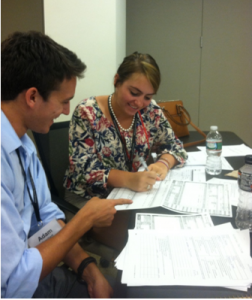By Liza Crawford, Media Relations Intern
As a communications intern at the American Red Cross, I see stories every day about our volunteers responding to disasters. Their names are rarely mentioned, but their impact is clear. When a disaster strikes, the Red Cross is there, supporting those who have lost everything, providing them with basic necessities and comfort and holding their hands as they embark on the long journey to recovery.
I joined the Red Cross because I wanted to be a part of this mission, so I jumped at the opportunity to step out of my comfort zone and learn what it takes to be a disaster responder. For two days, I joined several other interns in Disaster Action Team (DAT) training – a series of courses led by incredible volunteers who go out into the field at a moment’s notice to help clients in their time of need.
DAT training detailed how the Red Cross meets the needs of those affected by disasters, including psychological first aid and providing shelter, and completely changed my perspective on disaster response.
The training began with an overview of disaster services, led by volunteer Kim Lemoine. She set the tone with an opening statement: “I get so much more out of it than I give,” she said, holding back tears. Instantly, I understood how rewarding volunteering can be.

After covering the basics, the training became more focused. We learned how the Red Cross provides immediate relief. The instructors reviewed skills and techniques to properly address the needs of each person, and then split our group into pairs for a role-playing activity. Each pair read through a disaster scenario and took turns playing the affected person and the Red Cross caseworker.
The second day of training began with a course on psychological first aid. The Red Cross helps both disaster victims and volunteers deal with the stress and trauma. This course explained various symptoms that may signal the need for a mental health professional.
The final course outlined the fundamentals of opening a shelter. Relocating to a shelter can be extremely stressful for disaster victims, and we learned how to plan and communicate to ensure the most comfortable experience possible. Training concluded with an orientation for any interns who wanted to volunteer with the local chapter, the National Capital Region, and many of us did.
When my training was over, I had an overwhelming urge to go out and hug every DAT volunteer. Next time I see a news clip reading “The American Red Cross is assisting the survivors,” I will know how important that assistance truly is.
To learn more about becoming a Disaster Action Team member, please contact your local Red Cross chapter.
